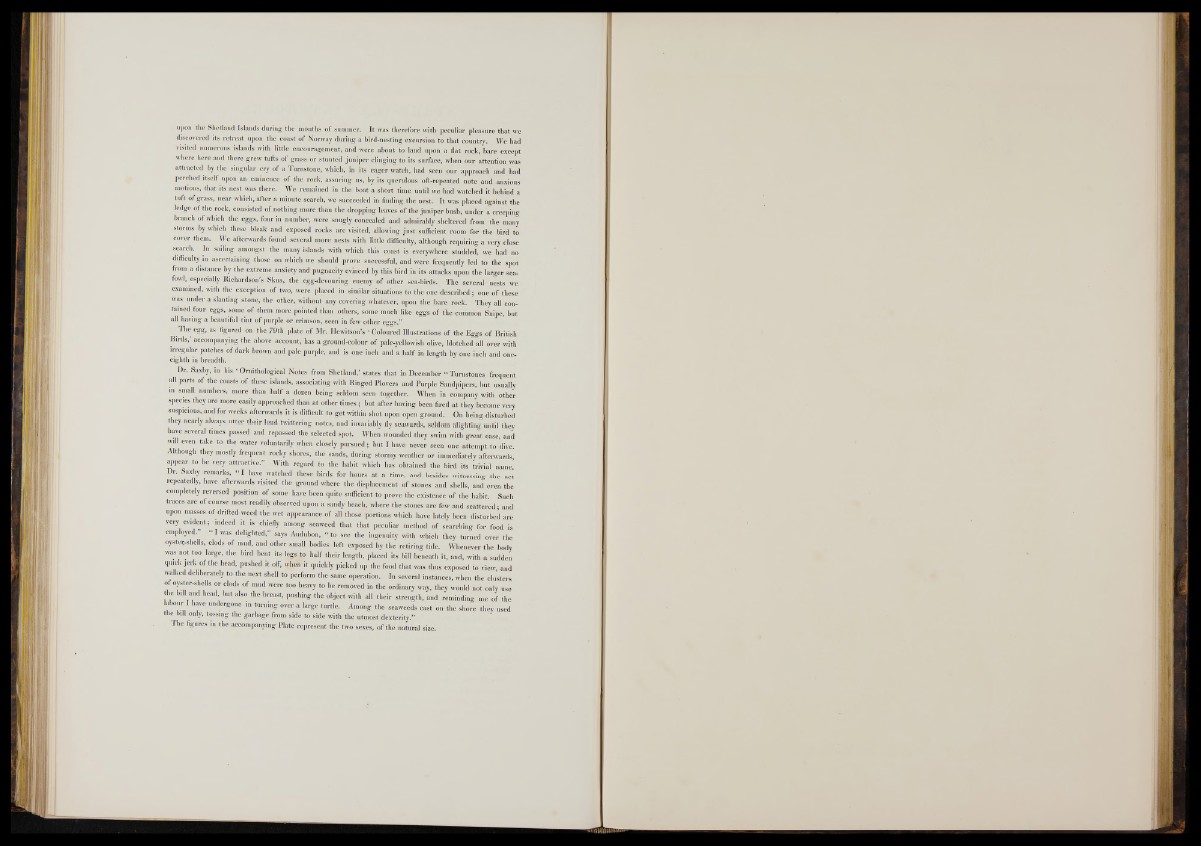
upon the Shetland Islands during the months o f summer. It was therefore with peculiar pleasure that we
discovered its retreat upon the coast of Norway during a bird-nesting excursion to that country. We had
visited numerous islands with little encouragement, and were about to land upon a «at rock, bare except
where here and there grew tufts of grass or stunted juniper clinging to.its surface, when our attention was
attracted by the singular cry of a Turnstone, which, in its eager watch, had seen our approach and had
perched itself upon an eminence o f the rock, assuring us, by its querulous oft-repeated note and anxious,
motions, that its nest was there. We remained in the boat a short time until we had watched it behind a
tuft o f grass, near which, after a minute search, we succeeded in finding the nest. I t was placed against the
ledge of the rock, consisted o f nothing more than the dropping leaves of the juniper bush, under a creeping
branch of which the eggs, four in number, were snugly concealed and admirably sheltered from the many
storms by which these bleak and exposed rocks are visited, allowing ju st sufficient room for the bird to
cover them. We afterwards found several more nests with little difficulty, although requiring a very close
search. In sailing amongst the many islands with which this coast is everywhere studded, we had no
difficulty in ascertaining those on which we should prove successful, and were frequently led to the spot
from a distance by the extreme anxiety and pugnacity evinced by this bird in its attacks upon the larger sea-
fowl, especially Richardson’s Skua, the egg-devouring'enemy o f other sea-birds. The several nests we
examined, with the exception o f two, were placed in similar situations to the one described ; one o f these
was under a slanting stone, the other, without any covering whatever, upon the bare rock. They all contained
four eggs, some of them more pointed than others, some much like eggs o f the common Snipe, but
all having a beautiful tint of purple or crimson, seen in few other eggs.”
The egg, as figured on the 79th plate of Mr. Hewitson’s ‘Coloured Illustrations of the Eggs o f British
Birds,’ accompanying the above account, has a ground-colour o f pale-yellowish olive, blotched all over with
irregular patches of dark brown and pale purple, and is one inch and a half in length by bn'e inch and one-
eighth in breadth.
Dr. Saxby, in his ‘ Ornithological Notes from Shetland,’ states that in December “ Turnstones frequent
all parts of the coasts of these islands, associating with Ringed Plovers and Purple Sandpipers, but usually
in small numbers, more than half a dozen being seldom seen together. When in company with other
species they are more easily approached than a t other times ; hut after having been fired at they become very
Susptcious, and for weeks afterwards it is difficult to get within shot upon open ground. On being disturbed
they nearly always Utter their loud twittering notes, and invariably fly seawards, seldom alighting until they
have several times passed and repassed the selected spot. When wounded they swim with great ease, and
will even take to the water voluntarily when closely pursued; but I have never seen one attempt to .’dive.
Although they mostly frequent rocky shores, the sands, during stormy weather or immediately afterwards
appear to be very attractive’:» With regard to the habit which has obtained the bird its trivial name,’
Dr. Saxby remarks, “ I have watched these birds for hours a t a time, and besides witnessing thé act
repeatedly, have afterwards visited the ground where the displacement o f stones and shells, and even the
completely reversed position of some have been quite sufficient to prove the existence o f the habit. Such
traces are of course most readily observed upon a sandy beach, where the stones are few and scattered ; and
upon masses of drifted'weed the wet appearance of all those portions which have lately been disturbed are
very evident; indeed it is chiefly among seaweed that that peculiar method o f searching for food is
employed.” “ I was delighted;” says Audnbon, “ to see the ingenuity with which they turned over thé
oysten-shells, clods o f mud, and other small bodies left exposed by the retiring tide. Whenever the body
was not too large, the bird bent its legs to half their length, placed its bill beneath it, and, with a sudden
quick je rk o f the head, pushed it off, when it quickly picked up the food that was thus exposed to view, and
walked deliberately to the next shell to perform the same operation. In several instances, when the clusters
o oyster-shells or clods of mud were, too heavy to be removed in the ordinary way, they would not only use
the bill and head, but also the breast, pushing the object with all their strength, and reminding me o f the
labour I have undergone in turning over a large turtle. Among the seaweeds cast o„ the shore they used
the bill only, tossing the garbage from side to side with the utmost dexterity.?* '
The figures in the accompanying Plate represent the two sexes, of the natural size.